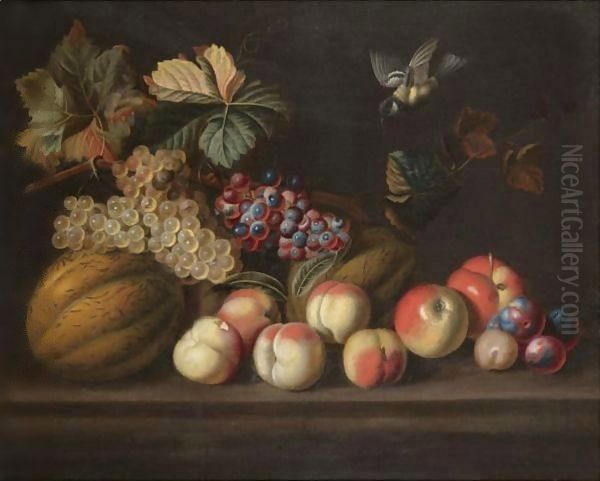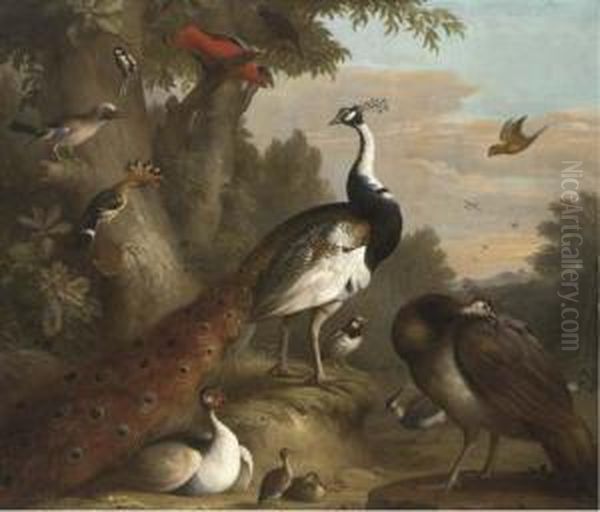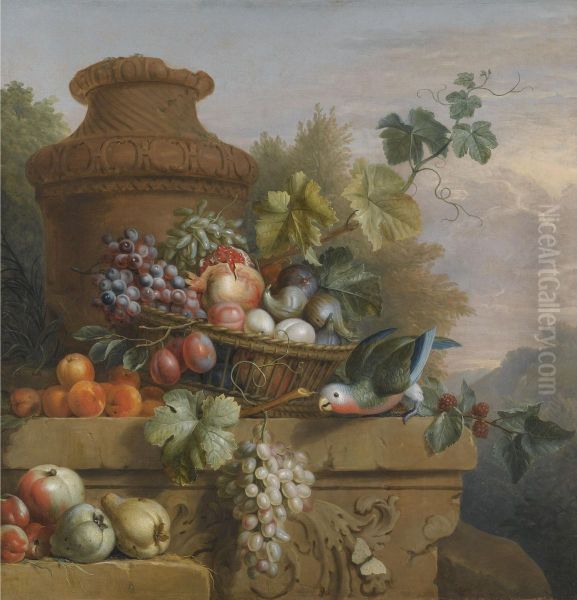Introduction: An Artist Bridging Cultures
Jakob Bogdani stands as a significant figure in late Baroque art, a painter whose life and work traversed geographical and cultural boundaries. Born in Hungary around the mid-17th century, he ultimately found fame and fortune in England, becoming one of the most sought-after still life and bird painters of his era. His meticulous depictions of flora and fauna, particularly exotic birds, not only showcased his exceptional technical skill but also reflected the burgeoning interest in natural history and global exploration that characterized the period. His success at the highest levels of British society, including royal patronage, cemented his place in art history as a master of decorative and naturalistic painting.
Early Life and Artistic Formation in Hungary and Holland
Jakob Bogdani's precise birth year remains slightly uncertain, with sources placing it either in 1658 or 1660. He was born in Eperjes, located in Upper Hungary, a region that is now Prešov in modern-day Slovakia. His origins were rooted in a Protestant noble family, and significantly, his father was also a painter. It is highly probable that Bogdani received his initial artistic training from his father, absorbing the foundational techniques of drawing and painting within the family environment. This early exposure undoubtedly shaped his artistic inclinations.
Seeking broader horizons and more advanced training, Bogdani traveled westward. By the mid-1680s (possibly earlier, though the provided text suggests mid-1660s which might be slightly early for his established career timeline, 1684 is often cited for Amsterdam), he was documented in Amsterdam. This move placed him in the heart of the Dutch Golden Age's artistic legacy. Though the peak decades of artists like Rembrandt van Rijn and Johannes Vermeer had passed, the Netherlands remained a powerhouse of artistic production, particularly renowned for its still life and genre painting. In Amsterdam, Bogdani reportedly lived with another still-life painter, indicating his immersion in the city's vibrant artistic community and his focus on the genre that would define his career. The influence of Dutch masters of still life, such as Willem Kalf known for his opulent pronkstilleven, or the detailed realism of Jan Davidsz. de Heem, likely informed Bogdani's developing style during this formative period.
Arrival and Flourishing Career in England

In 1688, a pivotal year in English history marked by the Glorious Revolution, Jakob Bogdani made the decisive move to London. This relocation proved immensely beneficial for his career. England, under the joint rule of the Dutch-born King William III and Queen Mary II, was receptive to artistic talent, particularly those demonstrating skills aligned with Dutch aesthetics. The royal couple themselves were significant patrons of the arts and had a known appreciation for Dutch painting styles, which likely created a favourable environment for an artist like Bogdani.
He settled in London, initially residing in the Tower ward and later moving to St Giles-in-the-Fields, where he would remain until his death. Bogdani quickly established a reputation for his exquisite paintings. His specialization in bird and flower subjects found a ready market among the English aristocracy and gentry, who sought decorative works to adorn their townhouses and country estates. He navigated an art scene dominated in portraiture by figures like Sir Godfrey Kneller and his predecessor Sir Peter Lely, but Bogdani carved out a distinct and successful niche for himself in still life and animal painting.
His talents did not go unnoticed by the Crown. Bogdani received commissions and patronage from the highest levels, including Queen Anne, who succeeded William III. His works entered the Royal Collection, a testament to his standing and the appeal of his art. This royal favour significantly enhanced his reputation and ensured a steady stream of commissions from other wealthy patrons, solidifying his position as a leading painter in his adopted homeland.
Artistic Style: Dutch Realism Meets Baroque Flair
Jakob Bogdani's artistic style is characterized by a meticulous realism deeply indebted to the Dutch tradition, combined with a decorative sensibility typical of the late Baroque period. His training in Amsterdam exposed him to the Dutch emphasis on close observation, detailed rendering of textures, and the skillful manipulation of light and shadow to create convincing representations of the natural world. This is evident in the precise depiction of feathers, petals, fruit skins, and reflective surfaces in his works.
He primarily worked in oils, employing fine brushes to achieve smooth finishes and intricate details. His compositions are often carefully arranged, balancing elements to create harmonious and visually appealing scenes. While realism was paramount, particularly in the accurate portrayal of species, Bogdani also incorporated Baroque elements such as dynamic arrangements, rich colour palettes, and sometimes dramatic lighting. His paintings were not merely scientific illustrations; they were intended to delight the eye and decorate lavish interiors.

Compared to the sometimes starker vanitas themes found in earlier Dutch still life, Bogdani's work often celebrates the beauty and abundance of nature. His flower pieces recall the work of Dutch specialists like Rachel Ruysch or Jan van Huysum, though perhaps with less complex symbolism. His bird paintings, while accurate, often arrange the subjects in lively, almost conversational groupings within landscape settings, adding a narrative or decorative dimension beyond simple portraiture.
The World of Birds: Observation, Exoticism, and Symbolism
Birds were arguably Jakob Bogdani's most celebrated subject matter. He possessed an extraordinary ability to capture the distinct character and plumage of a wide variety of avian species. His repertoire included native British birds but became particularly renowned for his depictions of exotic birds, which were increasingly finding their way into England through global trade and the establishment of aristocratic menageries. Parrots, macaws, cockatoos, and other colourful species from Asia, Africa, and the Americas feature prominently in his canvases.
These depictions reflect the era's growing fascination with the natural world, spurred by scientific inquiry and exploration. Bogdani's detailed portrayals served an almost documentary function for viewers unfamiliar with such creatures. His access to royal and aristocratic collections, including the menagerie kept by Admiral George Churchill (brother of the Duke of Marlborough) at Windsor, likely provided him with opportunities to study these rare birds from life. His work in this area can be seen as a precursor to later masters of ornithological art.
His focus on birds invites comparison with the great Dutch bird painter Melchior d'Hondecoeter, whose lively scenes of domestic and exotic fowl in park-like settings were highly influential. Bogdani adapted this tradition for an English audience. While celebrating the beauty of these creatures, some art historians suggest a deeper layer of meaning, interpreting the presence of caged or displayed exotic birds as subtle reflections of colonial expansion and the human impulse to collect and control nature, sometimes hinting at the displacement and mortality involved in bringing these creatures to Europe. His paintings stand in contrast to the more robust, often allegorical, animal scenes of Flemish artists like Frans Snyders.
Floral Compositions and Fruit Still Lifes

Alongside his famous bird paintings, Jakob Bogdani was also a highly accomplished painter of flower and fruit still lifes. His floral compositions typically feature arrangements of cultivated garden flowers – tulips, roses, lilies, carnations, and others – often displayed in ornate vases or baskets. These works demonstrate his skill in rendering delicate textures, vibrant colours, and the play of light on petals and leaves. They follow in the rich tradition of Dutch and Flemish flower painting, aiming for both botanical accuracy and decorative effect.
His style in flower painting has often been compared to that of Jean-Baptiste Monnoyer, a French artist who also spent considerable time working in England for aristocratic patrons, decorating palaces like Montagu House. Both artists excelled in creating lush, abundant floral displays suited to grand interiors. Bogdani's flower pieces were highly sought after and formed an important part of his output, commissioned for specific locations or acquired for private collections.
Bogdani also produced numerous still lifes focusing on fruit. These compositions often feature arrangements of apples, grapes, peaches, plums, and sometimes more exotic fruits, frequently combined with birds or insects to add life and interest. Works like Still Life with Apples and Grapes showcase his ability to capture the varied textures and colours of fruit, from the smooth skin of a grape to the rough peel of a melon. These paintings continued the tradition of still life as a genre celebrating nature's bounty and the painter's skill in mimesis. He often integrated fruit elements into his larger bird compositions, creating rich tapestries of natural forms.
Signature Works and Major Collections
Jakob Bogdani's prolific output means his works are represented in numerous significant public and private collections, primarily in the United Kingdom and Hungary. Several key pieces exemplify his style and subject matter:
One notable work is Two Iceland Falcons, housed in the Nottingham Castle Museum and Art Gallery. This painting showcases his ability to capture the fierce beauty and detailed plumage of birds of prey.
The Royal Collection Trust holds a significant number of Bogdani's paintings, reflecting his royal patronage. Examples include works historically recorded at Buckingham Palace, Windsor Castle, and Hampton Court Palace. Specific titles mentioned in sources include Red Lilies in a Vase, Herring Gull, Cormorant, and potentially pieces like Nile Geese (though the location "Cairo Palace" seems erroneous, likely referring to a Royal residence). These works often depict birds found in the royal menageries or gardens, as well as pure floral compositions.
His Still-life with Fruits, Parrots and White Cockatoo is a prime example of his elaborate compositions combining exotic birds and fruit, demonstrating his mastery of colour and texture. Such works frequently appear at auction and command high prices, indicating their continued desirability among collectors.
Other known works include Birds of England (cited as being in a Cambridge private collection), Fruit Bowl with Mulberries (associated with Windsor Great Park, likely part of the Royal Collection), and The Thieving Monkey held by the Maryhill Museum of Art in Washington State, USA, showing his occasional inclusion of mammals in his compositions. The Hungarian National Gallery in Budapest also holds important examples of his work, acknowledging his origins.
Bogdani in the Artistic Landscape of His Time
Jakob Bogdani occupied a unique position in the English art world of the late 17th and early 18th centuries. As a foreign-born artist, like Kneller (German-born) or Michael Dahl (Swedish-born) in portraiture, or the decorative painters Antonio Verrio (Italian) and Louis Laguerre (French), he contributed to the cosmopolitan nature of the London art scene. However, his specialization set him apart. While portraiture reigned supreme, Bogdani excelled in genres – still life, bird, and flower painting – that were highly valued for decorating the increasingly luxurious interiors of the aristocracy.
His most direct contemporary and potential rival in similar genres in England was Jean-Baptiste Monnoyer, particularly in flower painting. Both catered to the demand for ornate, naturalistic decoration. Bogdani's focus on birds, however, gave him a distinct edge and reputation. He effectively became the leading specialist in avian painting in England during his lifetime, building upon the earlier, perhaps less refined, work of native artists like Francis Barlow who depicted British wildlife and country sports.
His success demonstrates the opportunities available in England for skilled artists from the continent, particularly those whose style aligned with prevailing tastes influenced by Dutch and Flemish art. He successfully translated the traditions he learned in Amsterdam to suit the preferences of his English patrons, creating a body of work that was both technically accomplished and highly fashionable.
Legacy and Art Historical Assessment
Jakob Bogdani's legacy rests on his significant contribution to still life and animal painting in England. He is widely regarded as a master of the genre, particularly celebrated for his vibrant and detailed depictions of birds. His work brought a sophisticated, Dutch-influenced realism to these subjects, setting a high standard for subsequent artists. He effectively popularized the genre of exotic bird painting among the British elite, reflecting and perhaps even stimulating the contemporary interest in natural history and collecting.
Art historically, Bogdani is valued for his technical proficiency, his keen observational skills, and the sheer decorative beauty of his canvases. His paintings serve as valuable documents of the species known and prized in Europe at the time, including early depictions of birds newly imported from expanding global trade networks. The presence of these exotic creatures also offers a lens through which to consider the broader historical context of exploration, trade, and colonialism.
His influence extended beyond his immediate circle. His son, William Bogdani, followed him as a painter, though with less renown. His style likely influenced other painters working in similar genres in England in the early 18th century. Today, his works remain highly prized by museums and collectors, appreciated for their aesthetic appeal, historical significance, and masterful execution. His enduring popularity is even reflected in unexpected modern contexts, such as inspiring elements in virtual reality art installations, demonstrating the timeless appeal of his detailed natural worlds.
Conclusion: An Enduring Appeal
Jakob Bogdani's journey from Eperjes to the heart of the London art world resulted in a remarkable artistic legacy. As a Hungarian painter trained in the Dutch tradition who achieved fame in England, he embodies the cross-cultural currents of the Baroque era. His specialization in birds and flowers, rendered with meticulous detail and vibrant colour, perfectly suited the tastes of his aristocratic patrons, including British royalty. More than just decorative pieces, his works offer fascinating insights into the period's engagement with the natural world, scientific curiosity, and global connections. Bogdani remains a celebrated figure, a master whose canvases continue to captivate viewers with their intricate beauty and lively depictions of the avian and botanical realms.